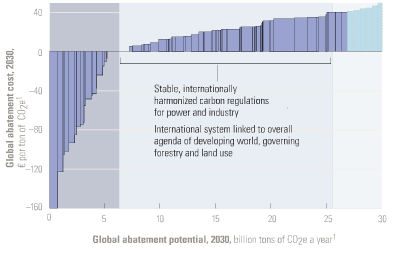I’m at CNAS’ climate war game listening to Diana Farrell from the McKinsey Global Institute. So far my takeaway from the exercise has been rather gloomy; Farrell presented a more hopeful view, informed by McKinsey’s construction of supply curves for carbon emissions reductions. I found her opening point particulaly critical: don’t wait for energy supply-side silver bullets to save us, when there are demand-side opportunities now.
McKinsey’s supply curves (and others from bottom-up modeling efforts) indicate large reductions available at low or negative cost. The idea of cheap negawatts has been around for a long time. Hard line economists have also been declaring the idea dead for a long time (see my old bibliography of the top-down/bottom-up debate).
Farrell noted several barriers to realizing apparently profitable efficiency investments:
- subsidies on existing inefficient or carbon-intensive options
- lack of information – e.g., inability of consumers to identify efficient options
- agency – e.g., landlords, tenants, and builders face different incentives
- financing – municipalities, schools and hospitals’ budgeting practices don’t favor capital investments that yield later savings (This was new to me; it’s a good example of the general difficulty in implementing worse-before-better policies.)
To take advantage of efficiency opportunities requires addressing these barriers. Economic objections to the concept of a free lunch from energy efficiency have often centered on the transaction costs involved in removing these barriers, which is sometimes sensible, but in general I find those arguments unconvincing – too often the logic starts with assumptions of first-best market equilibrium.
Farrell suggested four key policies needed to help realize the benefits of efficiency:
- efficiency standards for devices
- financing efficiency for buildings
- corporate energy efficiency standards
- using energy intermediaries
She also noted that policy itself is sometimes an obstacle, because firms hold back on investments when the policy environment is uncertain or turbulent. Industrial firms raised the same issue in a collaborative workshop on combined heat and power that I recently facilitated.
An audience member pointed out that the list is missing one key element: appropriate prices on carbon and energy. That’s true; setting a price on carbon would shift the zero point of the emissions supply curve curve, from the perspective of a carbon user, substantially increasing the scope of profitable emissions reductions available. In some cases, that may be sufficient to motivate action, but in many situations additional non-market policies are needed to address institutional and behavioral barriers.
Other participants raised objections to the potential for efficiency:
- inertia in development of familiarity with and adoption of new technology
- costly R&D
- rebound effects that consume the benefits of efficiency as amenities
I don’t find those arguments very compelling, particularly the last. Rebound effects are real: I’ll bet architects who specify CFLs also tend to spec more lumens. Vehicle technology improvements in the US in the 80s and 90s were almost entirely devoted to increasing weight, size, and power, and remaining efficiency gains were offset by increased driving. But that’s not a technology problem; it’s a price problem. Combine carbon efficiency with a carbon price and the rebound problem goes away. Also, many uses are essentially saturated or non-salient, and thus not subject to rebound. There’s no utility to the phantom load from power supply bricks, so eliminating it would not increase use.
In spite of objections, the potential for improvement is palpable. Farrell noted, “we have a climate change conference with a freezing room!” (Apparently Amory Lovins once calculated the energy cost of wearing ties). Yesterday I noticed that the refreshments in our country team room at the Newseum were served under a bank of twenty incandescent lights – at least 400 watts burning, in spite of the fact that the room was well-lit by three glass walls. The highlights on the napkins were nice, but I could live without that.
I would add a further note of optimism: for every cheap negawatt or negatonCO2 available from efficiency, there are several more available from redesign of complex systems like cities and changes and lifestyles, which don’t appear in the McKinsey accounts. Those are tougher to harvest. A city is a complex system with many moving parts that coevolve. It’s tough to design such a system from scratch and have it work, which may be why the FAA finds it so hard to redesign the national airspace. Nevertheless, some are trying with Masdar City. I wish them luck, but I think a more likely route to success is to correct price signals and institutions in order to get the landscape for evolution of technology, habits, and preferences tilted in the right direction.

